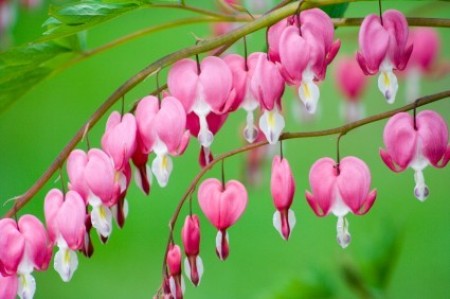
The old-fashioned bleeding heart has been a favorite flower for generations of gardeners. In fact, your mother or grandmother probably had bleeding hearts growing in their gardens. A perfect perennial for the shade. Its long arching stems of elegant, heart-shaped flowers dangle gracefully over mounds of dark, blue-green leaves. If you're considering adding this spring blooming beauty to your garden this year, here are some tips for growing them.
One look at bleeding hearts' flowers will tell you how these plants got their name. The pink or white-colored flowers are shaped like hearts with small drops of blood at the tips. These popular ornamental flowers have collected many common names throughout their long history. Some gardeners know them as 'Lady's locket', 'Lyre-flowers', 'Venus's car', 'Valentine flowers', 'Dutchman's breeches', or 'Naked lady-in-the-bath'. (Psst: If you turn a flower upside-down and gently pull the sides apart you'll expose the lady sitting in her bath.)
Bleeding hearts are easy-to-grow and once established offer an abundance of low-maintenance color season after season.
Common name: Bleeding heart (Dicentra spectabilis).
Flowers: Racemes of heart-shaped flowers in pink, white, cherry, or red; and white inner petals that appear to "bleed" from the tip.
Foliage: Dark blue-green; heavily lobed or lacy and fern-like. The foliage dies back after flowering.
Height/spread: 24-36 inches tall; 36 inches wide.
Site: Tailor made for shade gardens. Prefers partial to full shade. Will tolerate more sun as long as the soil remains moist.
Soil: Moist, fertile, and well-draining.
Planting: Potted plants can be planted anytime during the growing season. Handle the roots carefully as they are brittle and will break off easily. Unless fresh, the seeds can be difficult to germinate. Plant them in the spring after the danger of frost passes, or allow to self-seed in the fall.
Maintenance: No pruning or dead-heading required. Trim back foliage once it starts to decline.
Watering: Keep plants well watered throughout the summer, especially during dry periods.
Propagation: By seeds, cuttings, or division. Division is easiest and can be done every 2-3 years using a sharp spade. Divide plants in early spring, or as soon as the foliage dies back.
Popular cultivars: 'Alba' grows 2-3 feet tall with white flowers; 'Goldenheart' grows 2-3 feet tall with pink flowers and golden yellow foliage.

About The Author: Ellen Brown is an environmental writer and photographer and the owner of Sustainable Media, an environmental media company that specializes in helping businesses and organizations promote eco-friendly products and services. Contact her on the web at http://www.sustainable-media.com
Add your voice! Click below to comment. ThriftyFun is powered by your wisdom!
I love these plants, but have not had luck with them. Thanks for the tips...it does make more sense now. I do know that they need lots of water and its difficult to keep up with it when drought conditions roll in. Maybe I need a DIY sprinkler system?
Here are some gardening tips for drought conditions.
www.oldhouseweb.com/
Add your voice! Click below to comment. ThriftyFun is powered by your wisdom!